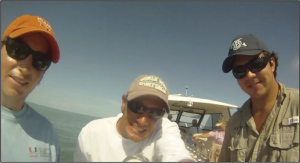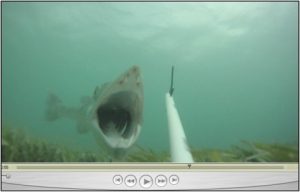Rockin’ n’ Rollin’ with Sharks
On Friday, August 19, we set out to our research spot in the Everglades with a boat full of eager donor participants. It’s always great to give young children the chance to get up close to sharks and let them formulate their own opinions before being tainted by false information—this trip was a great opportunity to do just this.
In addition to our standard shark surveys, some of our most recent trips have involved the implementation of new methods and technologies. With the academic year in a few days away, the RJ Dunlap program is busy inserting some new graduate research projects into the arsenal. It’s pretty cool to see so many different projects flowing together at once while we are on the boat.
On the way out, the boat was thoroughly entertained by musical samples from Pearl Jam’s extensive catalogue. With Dr. Hammerschlag on lead vocals and Austin on drums, good sharky vibes must have permeated the boat reverberated into the murky shallows of Everglades National Park.

The male representatives from RJD (Dr. Hammer, Curt, Austin) post Pearl-jam session, captured by one of our baited-underwater video systems. Eddie Vedder would be proud. Click to enlarge.
Soon after, we were pulling in our first shark of the day–none other than a healthy, 8 foot, male Carcharhinus leucas—a bull shark. Working with these predators seriously never gets old, and it is so humbling to be right on top of an animal so powerful and efficient. It’s hard to look this animal up and down and not see a perfectly designed creature—I challenge all of you—next time you see a shark up close, try to find an imperfection in design…there really aren’t any. Anyways, we affixed this shark—later named “Bubbles”—with a SPOT satellite tag. Throughout our entire sat-tag workup, we quantified the shark’s stress levels through behavioral observations, as well as assigning a release condition to gauge the efficiency of our tagging program while promoting shark health.
The day’s impromptu Pearl Jam session must have worked—as we ended up sampling a nice representative range of species including: blacktip, blacknose, nurse and lemon sharks. In addition to our standard sampling scheme (conventional tagging, measurements, biopsy), we also sampled and analyzed blood and gauged behavior (for stress physiology research) of these sharks.
In addition to the satellite tags and portable blood analyzers, we just began implementing more technology gear—underwater video systems—into our research program. The small cameras we use offer several advantages (size, durability, etc.) to our researchers. Our camera rigs allow for some interesting comparative work in conjunction with our standardized surveys, as well as using them to get unobstructed estimations of community structure and predator/prey interactions.

From one of our GoPro cameras: the business-end of a barracuda (after it hit the bait). Data to be used in predator/prey comparative study. Click to enlarge.
We also have some interesting novel applications of these cameras, which are evolving as we speak. After a few months of ironing out details and losing cameras (depressing), we have refined our methods with the camera systems …I can honestly say that we have already captured some pretty useful data and some really awesome predator behaviors…stay tuned to the RJD media pages for future updates.
Austin G.
Research Assistant

Leave a Reply
Want to join the discussion?Feel free to contribute!